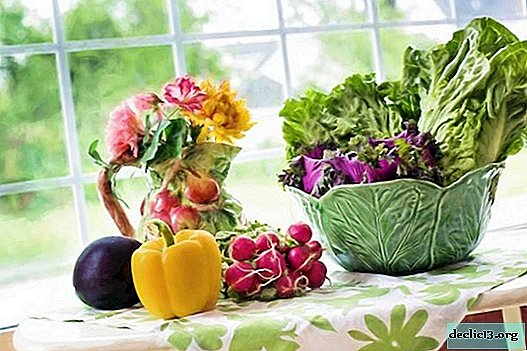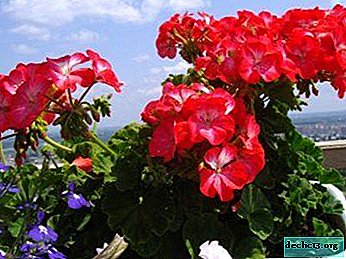How to plant and grow begonia from seeds at home?

In almost every house whose windows are decorated with flowers, you can see begonia. Bright and beautiful flowers perfectly fit into any interior, and in their magnificent flowering they are not inferior even to roses.
In addition, begonia can decorate any flower bed or flower garden, as it is grown in open ground, this requires varieties of garden begonia. Let's find out how to properly plant the seeds of this plant and how to take care of them so that they are well grown.
What kind of flower is this?
Begonia is an annual or perennial herbaceous plant of the begonia family. The genus includes about 1,500 species, which are represented by shrubs, shrubs, and "creeping" herbs. In the wild, it grows in places with a subtropical climate, characterized by high humidity, but can also be found on mountain slopes at an altitude of about 4000 meters.
Begonia was named after the Frenchman Michel Begon in the 17th century. He was the organizer of scientific research on the vegetation of the Antilles. Thanks to him, Charles Plumier's expedition took place, in which this bright plant was discovered.
 Begonia leaves are asymmetrical, with smooth or serrated edges. In many species, the lower part of the leaves, as a rule, has a red, brown or purple color. The upper part is usually green, but with various patterns and beautiful splashes.
Begonia leaves are asymmetrical, with smooth or serrated edges. In many species, the lower part of the leaves, as a rule, has a red, brown or purple color. The upper part is usually green, but with various patterns and beautiful splashes.
The plant boasts abundant flowering. Begonia flowers are monophonic: white, red, pink, orange, and with a fringing of various shades.
Breeding methods
Begonia propagates in the following ways.:
- cuttings;
- tuber division;
- leaflets;
- seeds.
Let us consider in more detail the method of propagation by seeds at home.
Seed material
Features
Obtaining begonia seeds is a very troublesome task, since in the conditions of free pollination they form a very small amount. The seeds are very small. Their length varies between 0.055 - 0.065 mm, and a width of 0.030 - 0.043 mm, they look like small grains of sand. One gram contains up to 40 thousand seeds. They are formed in seed boxes.
To increase the formation of the number of seeds, artificial pollination is carried out. Its essence is as follows: in July-August on the plot or in the greenhouse (if the crop is potted), pollen of the same variety is transferred with an ordinary brush on the stigma of female flowers. Artificial pollination increases seed formation by 4 times.
Collection
Seed collection must begin as the seed bolls dry and yellow. After removing the boxes, they are laid out on paper and allowed to dry. After about 7-14 days, the boxes burst and the seeds spill out onto the paper.
IMPORTANT! Over-ripening of seed bolls should not be allowed, as in this form, they easily crack, and the seeds spill out.After they are stored in paper bags in a cool dry place. Germination persists for 5 years, but its quality deteriorates every year.
Price
 Since begonia seeds are small, they are often sold in granules. The granule is a kind of shell, which consists of a mixture of special fertilizers. Granular seeds will germinate longer, but the quality of the plants will be noticeably better. On the left in the photo you can see how begonia seeds look - ordinary (smaller) and granular.
Since begonia seeds are small, they are often sold in granules. The granule is a kind of shell, which consists of a mixture of special fertilizers. Granular seeds will germinate longer, but the quality of the plants will be noticeably better. On the left in the photo you can see how begonia seeds look - ordinary (smaller) and granular.
Many specialized flower shops offer a wide range of different varieties and hybrids of begonia at different prices. It varies from 30 rubles. per bag of seeds, up to 100 rubles. and higher. In bags, usually from 4 to 10 seeds.
Features of this method
In order for begonia to please the eye with its wonderful flowering, it is necessary to grow it from seeds in seedlings. It implies the planting of seeds in special containers from January to February.
Landing time
The sowing period directly affects the flowering time, decorative qualities and even seed productivity. In this regard, the optimal sowing dates are determined based on the above factors.
In order for the begonia to bloom earlier, the seeds should be sown in January. By the time of its landing in open ground, it will have a sufficiently developed root system and the optimal size of the bush. With the January sowing period, flowering occurs in late May - early June.
IMPORTANT! If begonia seeds are planted too early, by the time they are planted in open ground, it grows. This fact negatively affects the survival rate of seedlings and the condition of the plant as a whole.Training
Most often, for growing begonias from seeds at home, amateur gardeners buy them in a store. You can purchase both granular and regular seeds.
 If possible, it is best to buy granular ones, since they are larger than ordinary ones and it is more convenient to distribute them on the soil surface, observing the required distance. Ordinary seeds are sown in a special container, and then seedlings are thinned out.
If possible, it is best to buy granular ones, since they are larger than ordinary ones and it is more convenient to distribute them on the soil surface, observing the required distance. Ordinary seeds are sown in a special container, and then seedlings are thinned out.
Begonia loves loose, fertile and slightly acidic soil. For planting seeds, you can use the soil purchased in the store. It has already added the necessary components in the right proportions.
How to plant?
Granular
Granular seeds are best planted in special tablets consisting of coconut or peat and humus.
Let us consider in stages the method of planting seeds in granules:
- It is necessary to place the tablets in a pan with water.
- After they get well wet, you need to spread the seed granules into tablets.
- Sprinkle lightly with water and cover with a glass or plastic jar.
After all the manipulations, you should regularly water and monitor the level of humidity. High soil moisture is dangerous for begonia.
The positive side of this method is the fact that there is no need to dive. The negative factors include the long-term germination of granular seeds.
Watch a video on how to use peat tablets to plant granular seeds.
Ordinary
How is sowing ordinary (not granular) seeds:
- For a more even distribution of seeds on the surface of the soil, they are mixed with sand.
- After sowing in a special container for seedlings, they cover it with a film (glass), put it in a warm room and provide regular watering. The air temperature should be in the region of 20-25 degrees. Lower temperatures can cause seed death.
- After emergence, the container must be rearranged in a bright place, for example, to the window. Lack of light can lead to excessive “stretching” of plants. The air temperature in this period should be about 12-15 degrees.
- When 2 to 3 true leaves are formed in the shoots, it is necessary to dive into separate containers.
Watch a video of sowing regular begonia seeds.
Choose the "right" pot
Begonia from seeds is grown by lovers of indoor floriculture as a perennial. In such cases, you need to properly treat the choice of pot. Any pot, regardless of size, must have drainage holes.
 Cuttings that have already taken root should be transplanted into small pots, the diameter of which is 5-6 cm.
Cuttings that have already taken root should be transplanted into small pots, the diameter of which is 5-6 cm.
After about 6 months, when the begonia root system has already formed, the plant should be transplanted into a larger pot (8-10 cm in diameter).
Further transplants depend on the growth and development of the plant and its root system. The diameter of each new pot should be 2 cm larger.
Soil requirements
Begonia loves loose, slightly acidic soil.. It can be purchased in a specialized store, or you can cook it yourself. Components and proportions for the preparation of soil for begonia:
- sheet land (2 hours);
- peat (2 hours);
- sand (1 hour).
The presence of sand provides the necessary friability of the soil, so it can be added to the soil mixture purchased in the store.
IMPORTANT! The sheet earth in the soil mixture should not contain tannins, which are contained in the leaves of oak and willow.Find out more about the preparation of the optimal soil for begonia in our article.
Home Care
Begonia is a shade-tolerant plant, but with sufficient lighting, its flowering will be more elegant. The best location for begonia is southwest or southeast windows..
In general, begonia is an unpretentious plant, but it can behave whimsically regarding watering.
Basic watering rules
Begonia loves well-moistened air, but at the same time does not tolerate an excess of moisture in the soil. Proper watering is to comply with the following rules:
- It is impossible to spray begonia, since water on the leaves can provoke the appearance of yellow spots. Humidify the air with a conventional humidifier.
- In the summer, it is recommended to place begonia pots in a pan filled with wet gravel.
- In winter, it is best to put dishes with water next to the plant. Its evaporation will provide optimum humidity.
- Begonia is watered, as a rule, once every 2 to 3 days. In the heat, an increase in the frequency of watering is permissible, and in winter - a decrease of up to 1 time in 5-7 days.
- It is necessary to water begonia with settled tap water. If the water is too hard, it is recommended to pass it through a filter or use cooled boiled water.
Recommendations for moisturizing young seedlings
 The root system in young seedlings of begonia develops very slowly, and in the initial stages is very weak. During this period, it is important to carry out proper watering, otherwise thin and short roots of seedlings may die.
The root system in young seedlings of begonia develops very slowly, and in the initial stages is very weak. During this period, it is important to carry out proper watering, otherwise thin and short roots of seedlings may die.
At a time when the seeds just hatch and the first sprouts appeared, preference should be given to watering with a spray.
Even at this time, you can use the lower watering system. It consists in the fact that boxes with seedlings are placed in a tray with water. Such irrigation will ensure the saturation of the soil with moisture and will not damage immature young plants.
Conclusion
Thus, following some rules, even a beginner grower will be able to try to grow beautiful begonias from seeds. Of course, this activity is rather troublesome, but worth it. After all, only by growing begonia from seeds, you can preserve the purity of the variety and enjoy the wonderful flowering for a long time.

















